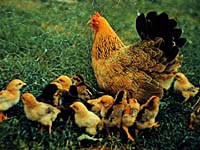The establishment of a commercial scale poultry operation requires a large capital investment for land, buildings, cages, feed handling and storage equipment. Feed, labour, veterinary and medication costs, and the cost of the chick will be the major expenses once an operation begins its production. The short production cycle for poultry requires a high quality environment to be maintained. Cleaning and disinfecting of buildings, cages and feeding equipment is done on a regular basis to minimize exposure to disease causing organisms. Environmental conditions including room temperature, humidity and litter and air quality, light intensity and photoperiod length are monitored with the use of computers. Many of these conditions can have severe effects upon the birds rate of growth and feed efficiency.
There are a number of different components to the production of poultry in Canada. These include:
- Primary Breeder Operations
- These operations are responsible for the development of genetic lines of poultry.
- They supply hatcheries with fertile eggs which will develop into commercial production birds.
- Hatcheries
- purchase fertilized eggs from the primary breeder and will incubate and hatch eggs
- sell chicks to the commercial producer when they are 1 day old.
- do not have to feed day old chicks because they can survive on the nutrients they absorb from the egg yolk
- Commercial Producer
- purchases day old chicks from a hatchery
- house and raise birds to a predetermined age or group weight at which time they will begin to lay eggs or will be slaughtered for meat depending on the breed
Meat producing birds are marketed before they reach sexual maturity. Broiler is the term given to birds marketed when they are 6 weeks of age or weigh approximately 2 kilograms. This is the most popular production program. They may also be marketed as roasters when they are 8 - 9 weeks of age and weigh 3.6 kilograms. Females are typically lighter and smaller in size. Birds will be purchased in groups as males, females or mixed sexes.

Only female chickens can lay eggs. These chickens are much lighter than the meat producing birds and weigh only 1.8 - 2 kilograms when mature. They will not begin to lay eggs until they reach 1.3 - 1.5 kilograms. The production stage for laying hens lasts about one year. During this time, a chicken will lay an egg most days and will commonly produce 300 eggs during her life. The hen reaches the end of her production stage when she begins to molt (lose her feathers). Hens will regrow their feathers after the molting stage and will begin to lay eggs once again. These eggs are usually smaller in size and fewer in number. Because of this reduced productivity, it is not usually profitable to house and feed hens through the molting stage and they are often replaced. When hens stop producing eggs, they are slaughtered and may be used for meat, or processed into animal feeds.
|
